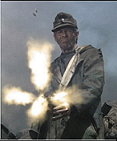bednarre
Posts: 128
Joined: 2/23/2011
Status: offline

|
If the German unit is fortified and supplied, it is basically invincible. This specifically means a single infantry division. Thus you must base your defense on the assumption that high priority areas which are seized cannot be retaken (unless isolated). German units can thus only be successfully attacked if isolated, or unusually weak and unfortified. On the other hand German Allies units are fair game, even in fortifications, except for the Fins of course.
As stated before, I think the Russian offensive capability in 1941 and 1942 in the game is grossly underestimated. The first successful defensive engagement in the war, Brest-Litovsk, cannot be achieved in the game (fell on June 30). At the Berzina River crossing near Orsha Russian counterattacks were vigorous. This caused the German Second Panzer Group to halt on the Dnepr, and the Third Panzer Group was stalled at Vitebsk in July 1941. The Germans had stalled because the Russians were effectively attacking! Because little territory was taken, this decisive engagement is not well known. By July 16 the 18th Panzer Division only had 12 tanks operational. From July 20 to July 26 the Russians successfully attacked and over 100,00 men escaped in 3 encircled Russian armies at Smolensk. From August 30 to September 8 another massive Russian offensive involving 3 fronts recaptured Smolensk! On September 6 the Germans had to withdraw from the Yel'nya salient. From August 21 to 25 the Russian Army retook Velikiye Luke, and broke into the rear areas with cavalry. On November 26 the I Guards Cavalry Corps caused the Germans to retreat 40 kilometers. On August 19, 1942 the Russian counterattack broke the front near Leningrad and created a large salient. The situation was only restored when several German divisions reserved for a new attack on the city had to be diverted. The Russian Kharkov offensive was from May 12 to 19, 1942, and penetrated 50 kilometers in depth and 60 kilometers with width. There were probably many more successfully examples. What is clear is that most of the Russian attacks in the first year of the war failed, but not all!
Also, the Russians attacked the Germans on a continuous basis. The question is why? First, it was very difficult for the Russians to defend against the German mechanized units, which could pick the time and location to break through. In effect, only a small portion of the defensive forces come into action, and the rest are surrounded or forced to retreat if there is a breakthrough. By attacking, a majority of the troops could get into action. Yet with so many unsuccessful attacks and very casualties, why did the Russian High Command continue with this strategy? The reason was that the German took casualties as well, probably more than if they were attacking the Russians. Instead of offensive operations, many German divisions had to go over to the defensive or shift to a threatened sector. This helped stall the offensive. The game could simulate this by having the Russians attack with high casualties, but with some hope of success.
Currently the game models this kind of attack as "suicidal" with almost no German casualties. To model the limited but possible success in actual history, I suggest that the Russian offensive (and probably defensive) CV have a great variation, not factoring in leadership effects! This can be done with a Russian CV uncertainty factor, which multiplies the CV of all of the attacking units (i.e., the factor is only computed once per attack, and once per unit). This can be done mathematically with the following options (the mean is always 1:1):
_______________Probability Per Option and Russian Uncertainty Factor
_____Factor______1/4________1/2_______1_________2________3______
Option
__1____________24.83%____25.22%___26.00%___16.65%____7.29%
__2____________19.66%____24.22%___33.33%___18.71%____4.08%
__3____________29.18%____26.07%___19.84%___14.92%___10.00%
For example, if the highest possible probability for the 1:1 factor is desired, Option #2 would be ideal. A CV factor of 1/4 would occur 19.66% of the time, compared with 33.33% of the time for a 1 factor, and 4.08% for a 3 factor. This means that a little over 4% of the time the Russian attack CV would be tripled and about 20% of the time it would be quartered! Option #1 offers a middle of the road distribution, with almost equal probability from 1/4 to 1. This gives a little over 7% chance at a 3:1 factor. Option #3 offers the wildest gamble, maximizing the 3:1 factor at 10%, while resulting in a 1/4:1 factor of about 29%! Suppose 6 Russian divisions are attacking, with a combined attack CV nominally of 6. A typical German division would be about 12 in 1941 and 10 in early 1942. With no uncertainty factor, the Russians attack at 1:2 odds, and suffer high casualties (like 3000 men) with little German casualties (like 100 men). With uncertainty factor option #1, there is about a 24% chance the net Russian CV will be at least 12. On the other hand, there is about a 25% chance the Russian CV will be 1.5 and about a 25% chance it will be just 3. These will obviously result in much higher casualties than typical. The net result is to give the Russians some reasons for attacking in 1941 and early 1942, and perhaps allow the player to suffer tremendous losses while doing it!
|
 Printable Version
Printable Version











 New Messages
New Messages No New Messages
No New Messages Hot Topic w/ New Messages
Hot Topic w/ New Messages Hot Topic w/o New Messages
Hot Topic w/o New Messages Locked w/ New Messages
Locked w/ New Messages Locked w/o New Messages
Locked w/o New Messages Post New Thread
Post New Thread